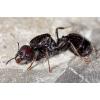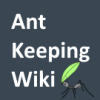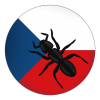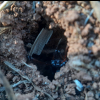After reading many journals, I learned that it is common for semi-claustral queen or founding colony tubes to get heavy layers of mold on the cotton eventually. I then realized that I never got mold on the cotton of my tubes. Even though having mold is a bad thing, it made me wonder if I was feeding my ants something wrong or if the cotton contained antibacterial chemicals. So far, every queen that I've caught in CT is still alive (except for one wild caught colony), and they've been in those tubes.
I think that I might have figured out why my tubes never mold.
Whenever I put a piece of cotton in a tube, I cover the exposed part with a little bit of filter paper or tissue to make it more difficult for the ants to pull at. It also makes it harder for the ants to bury their food in the cotton, Since the only uncovered part is the dry cotton, they stuff their food scraps and feces in the cotton plug, which can easily be cleaned.
I also use freshly filtered water instead of distilled or bottled water. This might not have anything to do with the lack of mold, but I think that distilled water may pick up harmful mold spores when sitting out.
NOTE: This does not work with termites.
You can see a drawing of what I mean here: https://scratch.mit....jects/192981209

























